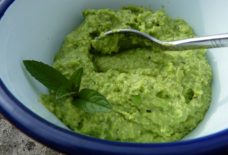What to Expect at a Moroccan Dinner Party
By: Nouha Elyazidi / Arab America Contributing Writer
Congratulations, you have been invited to a feast unlike any other. You will experience an evening of exceptional hospitality, lots of laughs, and great meals (yes, meals plural!) Moroccans are known for their hospitality and generosity, mainly demonstrated through their great gatherings.
Here is some of the best advice for guests attending a Moroccan gathering for the first time. If you are invited to a Moroccan dinner, the hosts will tell you it will be a simple dinner, but that could not be farther from accurate. In preparation, I would suggest eating a light lunch to make room for the dinner, you will be eating a lot, trust me. In Moroccan culture, guests never arrive empty-handed. Most guests will bring something homemade, typically sweets such as cookies, cake, or sweetbreads. But do not fret if cooking or baking is not your strong suit, something store-bought is just as good. In addition, if it is the first time you are visiting someone’s home, or you are visiting for a special occasion, bringing flowers would be a nice touch.
Okay so now we are in the door; literally. Once you enter the home, make sure to take your shoes off! Even if the hosts insist you keep them on, they are doing that as a formality. Moroccans are huge on cleanliness so shoes in the house are considered rude. Once at the gathering ensure you greet everyone. It is considered rude if you do not individually greet everyone so ensure that you say “Salam” to all the attendees. Most men greet each other with a firm handshake and sometimes a hug or kiss on the cheek. Most women greet each other with three kisses on the cheek. The genders are usually separated so when greeting the opposite gender no physical touch is needed, a smile and a verbal greeting should suffice.
Once you are seated, the host will bring out the appetizer. Moroccan appetizers are usually salads, but there are many different types of salads. The most common salad for gatherings is called “shlada malakia/شلاضة ملكية” which translates to “royal salad.” Shlada malakia is one large salad made from smaller salads assorted on one large plate. The center is a salad made with corn, tuna, and white rice mixed with a mayonnaise vinaigrette. Surrounding it could be any combination of beet salad, a carrot salad, seasoned green beans, or a peas and potato salad. Moroccans are huge on food presentation, so the salads are carefully molded and assembled. The platter is usually decorated creatively, a few examples of the possible toppings are baby corn, salami, tomatoes, eggs, cheese, lettuce, calamari, avocados, shrimp, olives, etc. The salad is usually very colorful and tastes wonderful, but do not get too full because we still have more courses to come!
Photo: Salade Royal- YouTube; سلطة ملكية
There are countless dishes that can be served in this second course but I will list a few possibilities. Moroccan couscous is one of the best-known dishes in Morocco, it is typically served on Fridays so if you happen to visit on a Friday, you are in for a treat. Another possibility would be a tagine. Tagines are dishes prepared in a clay pot over a fire-top and can feature chicken, fish, lamb, or beef and then a vegetable on top. Bastila could also be served, it is a dish that features either chicken or seafood. Seafood bastilla is a filo dough stuffed with vermicelli noodles, shrimp, calamari, a fish of choice, and mushrooms. Chicken bastilia is also prepared with filo dough but it is stuffed with shredded chicken and ground nuts. These are just to name a few possible dishes! Moroccan dishes are almost always served on one plate to be shared by everyone at the table.
Feeling full? Well, I hope not because we have a second main course coming. Yes, that is correct, a second course. The majority of gatherings will feature two main courses, usually one of another meat. So for example, if the first dish was made from lamb like tagine, the second will probably feature chicken or seafood like bastilla, and vice versa.
Wasn’t that delicious! Now is the point where most people regret not wearing stretchy pants. It is time for the third round of food. The third round of food is a large serving of fruit. A plethora of different fruits are served depending on what is available in your area and the season. The colorful assortment of fruits is often displayed creatively and many pride themselves on cutting their fruits into creative shapes and designs.
Photo: Atef Barbouche
Before you go into a food coma, I promise this is the last course, dessert! The most important thing served at a Moroccan dessert table would of course be Moroccan mint tea. The tea is prepared in a traditional Moroccan teapot called a berrad. Accompanying the tea are usually Moroccan cookies, these are timeless cookies usually made from nuts that pair perfectly with tea. Nuts and dates stuffed with nuts will probably be served. Lastly, cakes and sweetbreads might also make an appearance. The desserts usually vary depending on your host’s preference.
After the desert, the gathering will typically come to a close. The night will finish with more talking and laughter, but then my friends, the night of great food and warm hospitality will come to an end. As you prepare to leave, do not forget to thank your hosts numerous times for their hospitality. Now, you are well prepared for a Moroccan gathering!
Check out Arab America’s blog here!








